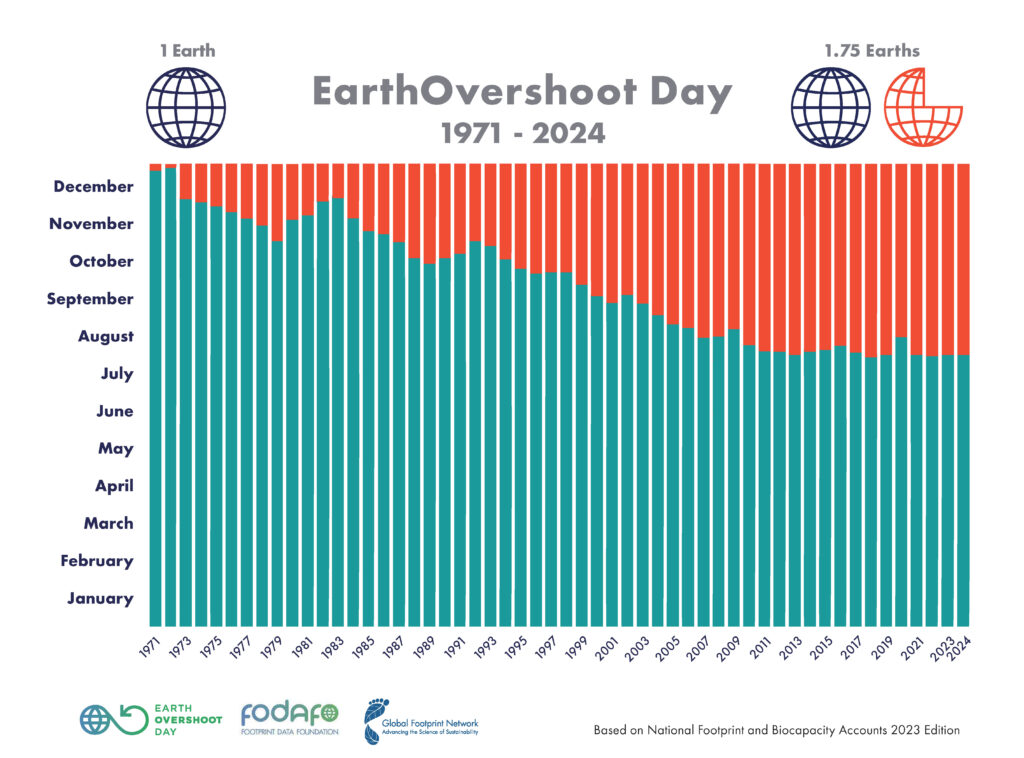
To determine the date of Earth Overshoot Day for each year, Global Footprint Network calculates the number of days of that year that Earth’s biocapacity suffices to provide for humanity’s Ecological Footprint. The remainder of the year corresponds to global overshoot. Earth Overshoot Day is computed by dividing the planet’s biocapacity (the amount of ecological resources Earth is able to regenerate that year), by humanity’s Ecological Footprint (humanity’s demand for that year), and multiplying by 365, the number of days in a year (or 366 days in a leap year, as for 2024):
(Planet’s Biocapacity / Humanity’s Ecological Footprint) x 366 = Earth Overshoot Day
Global Ecological Footprint and biocapacity metrics are calculated each year in the National Footprint and Biocapacity Accounts. Using UN statistics, these accounts incorporate the latest data and the most updated accounting methodology (the National Footprint and Biocapacity Accounts 2023 Edition feature 2019 data.) To estimate this year’s Earth Overshoot Day, Ecological Footprint and biocapacity are “nowcasted” to the current year using the latest data from additional sources, such as the Global Carbon Project.
To maintain consistency with the latest reported data and science, the Ecological Footprint metrics for all past years since 1961 (the earliest year data is available) are recalculated every year, so each year’s metrics share a common data set and the exact same accounting method. The annual dates of Earth Overshoot Day are recalculated accordingly.
Consequently, it is inaccurate to simply look at media accounts from previous years to determine past Earth Overshoot Days. Indeed, a true apples-to-apples comparison of Earth Overshoot Days can only be made using the same edition of the National Footprint and Biocapacity Accounts. For instance, it would make no sense to compare the date of Earth Overshoot Day 2007 as it was calculated that year—and reported by the media at the time—with the date of Earth Overshoot Day 2024, because improved historical data and new findings such as lower net carbon sequestration by forests have slightly shifted the results. Even a few percentage points change can shift the date of Earth Overshoot Day by a good number of days. Therefore, for time trends, consult the Footprint Data Platform.
Given the cumulative effect of overshoot, which leads to a build-up of this deficit into a debt, the precise Earth Overshoot Day date for each year is less significant than the magnitude of the ecological overshoot. The overall trend of the date progression year over year—which, as you now understand, is identical to that of the ratio of humanity’s Ecological Footprint to our planet’s biocapacity. Over the last decade, the date has been staying more steady. This means that humanity is adding further damage to the biosphere at constant rate.
The dates of past Earth Overshoot Days, as calculated with and extended from the National Footprint and Biocapacity Accounts 2023 Edition, are:
December 25, 1971
December 27, 1972
December 3, 1973
November 30, 1974
November 27, 1975
November 21, 1976
November 17, 1977
November 12, 1978
November 1, 1979
November 16, 1980
November 20, 1981
December 1, 1982
December 4, 1983
November 17, 1984
November 7, 1985
November 5, 1986
October 30, 1987
October 16, 1988
October 13, 1989
October 18, 1990
October 20, 1991
October 30, 1992
October 27, 1993
October 16, 1994
October 9, 1995
October 4, 1996
October 6, 1997
October 7, 1998
September 26, 1999
September 17, 2000
September 13, 2001
September 19, 2002
September 12, 2003
September 2, 2004
August 27, 2005
August 24, 2006
August 15, 2007
August 16, 2008
August 23, 2009
August 10, 2010
August 6, 2011
August 4, 2012
August 3, 2013
August 5, 2014
August 7, 2015
August 9, 2016
August 5, 2017
August 1, 2018
August 3, 2019
August 16, 2020
August 3, 2021
August 1, 2022
August 2, 2023
August 1, 2024
*The calculation of Earth Overshoot Day 2020 reflects the initial drop in resource use in the first half of the year due to pandemic-induced lockdowns. All other years assume a constant rate of resource use throughout the year.
